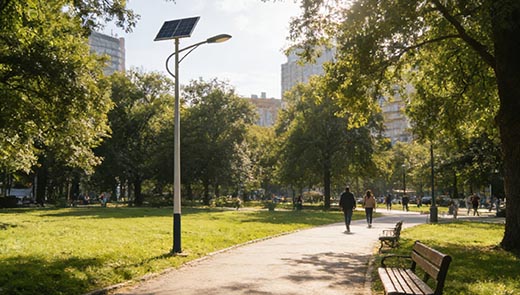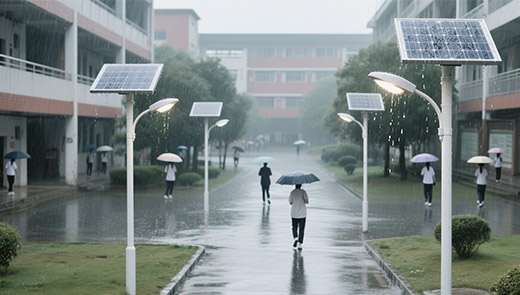How is the color temperature of street lights selected?
As night falls, street lights serve as guardians of the city, illuminating the path for pedestrians and vehicles. Among the many parameters of street lights, color temperature is an often overlooked yet crucial factor. It not only determines the warm or cool hue of the light but also plays a key role in energy consumption, road safety, and environmental adaptation. Selecting the appropriate color temperature enables street lights to deliver illumination while achieving multiple values: energy efficiency, safety, and practicality. So, how exactly should the color temperature for street lights be chosen? This article will explore the topic in detail, covering the fundamentals of color temperature, its impact on the energy efficiency and visibility of solar street lights, and the reasons why most solar street lights adopt cool white color temperatures.
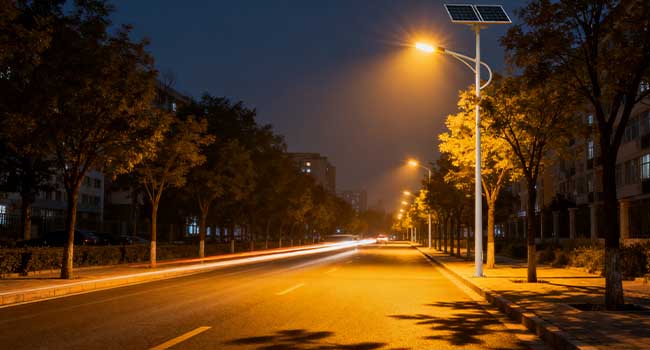
Fundamentals of Street Light Color Temperature
Color temperature is a scale measuring the light color of a light source, expressed in Kelvin (K). It is determined by heating a standard black body. As the black body's temperature rises to a certain level, the color of its emitted light gradually changes. The temperature at this point represents the light color of the source. For street lights, selecting the right color temperature is crucial. An appropriate color temperature not only ensures effective road illumination but also impacts energy consumption, traffic safety, and the surrounding environment.
How does Color Temperature Affect the Energy Efficiency of Solar Street Lights?
Color temperature impacts luminous efficacy, which directly relates to the energy consumption of solar street lights. Generally, light sources with different color temperatures produce varying luminous flux (measured in lumen) at the same power consumption. Cooler color temperatures above 4000K generate more lumen per watt, delivering more significant energy savings. In contrast, warmer color temperatures between 2700K and 3000K emit a more comfortable light but produce relatively fewer lumen per watt. As shown in the table below:
|
Color Temperature Range |
Energy Performance Characteristics |
|
Above 4000K (Cool White) |
Produces more lumen per watt, delivering more significant energy savings |
|
2700K–3000K (Warm White) |
Emits comfortable light but produces fewer lumen per watt |
How does Solar Street Light Color Temperature Affect Visibility?
Driver Safety and Road Recognition
Color temperature significantly impacts driver visibility and reaction times. Studies indicate that compared to warm color temperatures, cool white light (4000K-5000K) offers superior contrast recognition for road surfaces, lane markings, and potential hazards. This enhanced contrast, particularly under adverse weather conditions with inherently poor visibility, reduces accident rates and improves overall road safety.
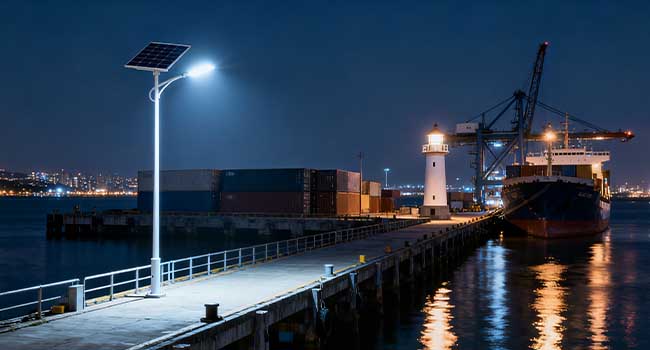
Pedestrian and Cyclist Detection
In mixed-use zones, accurate detection of pedestrians and cyclists is crucial for evaluating solar street light effectiveness. Cool white solar lighting systems provide superior color rendering for clothing and reflective materials, making pedestrians more visible to drivers. This enhanced detection capability is vital at intersections and crosswalks where multiple user groups coexist. Simultaneously, color temperature selection directly impacts facial recognition and body motion detection under solar lighting, thereby affecting security monitoring and pedestrian safety.
Weather Performance and Atmospheric Penetration
Different color temperatures exhibit varying performance under diverse weather conditions, a factor that must be considered in solar lighting system design. Cool white light generally penetrates fog and light precipitation more effectively than warm white light, maintaining visibility during adverse weather. For regions prone to frequent fog or heavy winter precipitation, selecting a higher color temperature helps sustain adequate illumination levels. This weather performance factor becomes even more critical in areas with rapidly changing atmospheric conditions, such as coastal zones or mountainous regions.
Why do Most Solar Street Lights Use Cool White Color Temperature?
Manufacturing Standards and Industry Practices
The solar street light industry has largely standardized on cool white color temperatures (4000K-6500K) due to a convergence of factors including regulatory requirements, energy efficiency standards, and proven performance data. Most manufacturers design products to meet international lighting standards specifying minimum illumination levels and uniformity requirements, which cool white LED more readily achieve. This standardization has created economies of scale in solar street light production, making cool white options more readily available and cost-effective for large-scale installations.
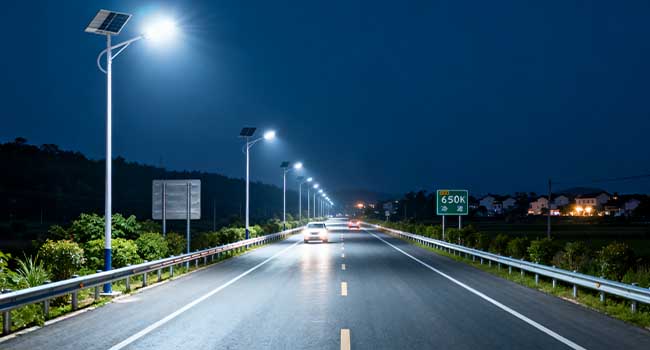
Municipal Preferences and Regulatory Compliance
Government agencies and municipal authorities often specify cool white color temperature for solar street light projects based on established safety standards and energy efficiency regulations. This preference stems from extensive research demonstrating that cool white solar lighting systems provide optimal traffic visibility while minimizing energy consumption from limited battery resources. Additionally, many solar lighting installations must comply with dark sky regulations, which favor specific color temperature ranges to reduce light pollution impacts on astronomical observation and wildlife behavior.
Cost-Effectiveness and Maintenance Benefits
Cold white LED used in solar street light systems typically offer longer lifespans and more stable light output compared to other color temperature options. This longevity advantage reduces replacement costs and maintenance frequency for solar street light installations, making them more economically attractive for long-term urban planning projects. Simultaneously, the widespread adoption of cold white technology in solar street light applications has driven component standardization, ensuring better availability of replacement parts and technical support throughout the system's lifespan.
When selecting the color temperature for street lights, multiple key factors must be comprehensively considered. In terms of energy efficiency, cooler color temperatures offer greater advantages in energy savings. Regarding visibility, cool white light provides superior recognition effects across various scenarios. From practical perspectives such as manufacturing, municipal requirements, and maintenance costs, cool white color temperatures are also more favored. Therefore, in practical applications, a comprehensive balance must be struck between energy efficiency, visibility, and various practical considerations to select the most suitable color temperature for street lights, thereby achieving optimal lighting effects and overall benefits.

